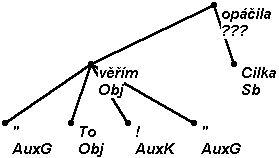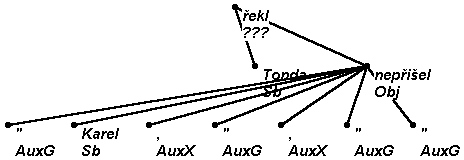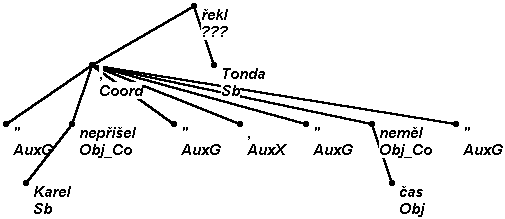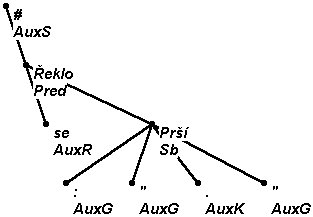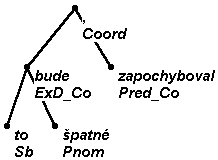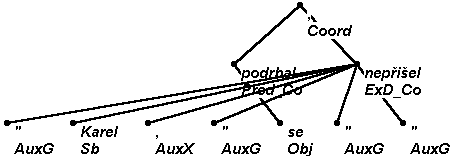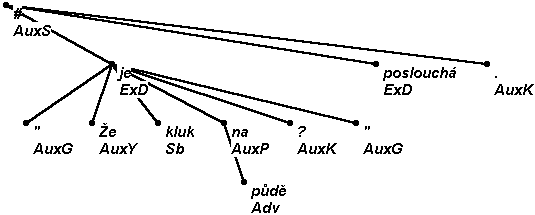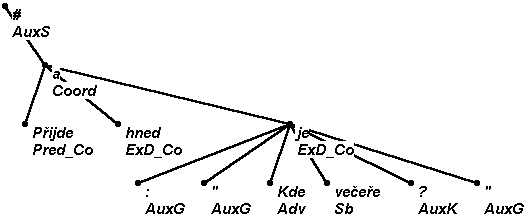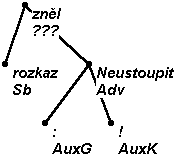In this part we describe some phenomena that concern more than a single category and thus it is necessary to mention them in one section.
Direct speech reproduces what has been said (thougt of) by someone in a direct way, word-for-word. The reporting clause indicates who uttered the speech, in which way, under which circumstances etc. Thus two layers are concerned, utterances by two speakers: the speaker who reports, and the speaker whose utterance is reproduced.
A semi-direct speech is not graphically marked by inverted commas and it uses only the third person, rather than three grammatical persons. The "improper direct speech" differs from direct speech only in writing: it is not separated from the reporter's speech graphically. It is analyzed in the same way and according to the same criteria as direct speech.
In spite of the fact that direct speech is sometimes characterized as a free connection of sentences, we analyze it (be it proper, improper, or semi-direct) in the same vein as indirect speech proper.
Direct speech is often included in inverted commas. The reporting clause may be placed in front of the reported speech (separated by a colon), after it, or it may be inserted into the reported speech (in the two latter cases it is separated by comma(s)). The comma may be replaced by a question mark or an exclamation mark. All these punctuation marks are suspended on the governing node of the reported speech. Cf. Terminal symbol of the sentence AuxK, Comma AuxX, and Punctuation, other graphic symbols AuxG (esp. the parts Bracketing AuxG and Introducing punctuation (colon)).
The relation between the reporting clause and the reported speech is represented in the following way:
-
The governor od the reporting clause is a verb that requires Obj or Sb, which are missing in the clause. (Sb will be missing if the reporting clause is in passive.) The governor of the reported speech is then assigned the function of the missing element, i.e. Obj or Sb.
This case is illustrated by five examples: in (1.a) the reporting clause is placed after the reported speech, note the placement of the nodes for the punctuation marks. In (1.b) and (1.c) the reporting clause is inserted into the reported speech: in (1.b), the reported speech consists of a single clause and the reporting clause is placed in the middle of it; in (1.c), the reporting clause is placed in between two coordinated clauses. Ex. (1.d) illustrates a situation when the reporting clause stands in front of the reported clause and has the function of Sb. The reported speech in (1.e) is not a complete sentence and therefore the afun ExD is assigned.
A note on the placement of punctuation marks in (1.b) and (1.c): In (1.c) the reported speech is a coordination, therefore the comma after its first part (which is inside inverted commas) is used as a symbol for coordination (with afun Coord) and the remaining second comma is suspended as an introducing punctuation mark. On the other hand, we do not need a symbol of coordination (coordination is not the case) in (1.b), and thus both commas serve as separating punctuation marks.
Examples of verbs with which the reported speech functions as Obj (in active):
- verbs of saying
- pravit say, říci say, opáčit return, odpovědět answer, ptát se ask
- verbs of information
- oznámit announce, naznačit indicate
- verbs with an emotional load
- verbs of sensation
- verbs of volition
- slíbit promise, nabízet offer, navrhovat propose, doporučovat recommend, radit advise, žádat require, prosit beg
Examples of verbs with which the reported speech functions as Sb:
-
Cases for which the criterion given in (1) cannot be used, but it is possible to add into the reporting clause such verbs as a řekl (and he-said), řekl a (he-said and), přičemž řekl (while he said). The complex sentence is then analyzed as a coordination of two sentences, the governor of the reported speech gets the function ExD_Co (i.e. its own governor is missing).
In (2.c) and (2.d) there is no node that could be assigned the function of Coord, and therefore this situation is analyzed by means of ExD. In the complex sentence of (2.e) a part of the reporting speech a řekl (and he-said) is included, the conjunction a (and) fulfilling its normal coordinating function; however, the word řekl (he-said) is again deleted, and the nodes for hned (immediately) and je (is) which would depend on the deleted řekl are assigned afun ExD_Co.
-
It may sometimes happen that a statement, quotation etc. has some function other than that of a direct speech. The governor of such a statement is assigned afun according to the function it represents (usually Adv). This way of representation is used only in case when no other way is possible.
